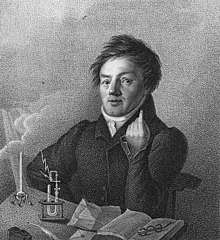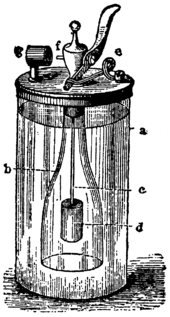Johann Wolfgang Döbereiner
| Johann Wolfgang Döbereiner | |
|---|---|
 Johann Wolfgang Döbereiner | |
| Born |
13 December 1780 Hof, Principality of Bayreuth |
| Died |
24 March 1849 (aged 68) Jena, Grand Duchy of Saxe-Weimar-Eisenach |
| Nationality | German |
| Known for |
Döbereiner's triads Döbereiner's lamp |
| Scientific career | |
| Fields | Chemistry |
| Institutions | University of Jena |
Johann Wolfgang Döbereiner (13 December 1780 – 24 March 1849) was a German chemist who is best known for work that foreshadowed the periodic law for the chemical elements and inventing the first lighter, which was known as the Döbereiner's lamp.[1] He became a professor of chemistry and pharmacy at the University of Jena.
Life and work
As a coachman's son, Döbereiner had little opportunity for formal schooling. So he was apprenticed to an apothecary, reading widely and attending science lectures. He eventually became a professor at the University of Jena in 1810; he also studied chemistry at Strasbourg. In work published in 1829,[2] Döbereiner reported trends in certain properties of selected groups of elements. For example, the average atomic mass of lithium and potassium was close to the atomic mass of sodium. A similar pattern was found with calcium, strontium, and barium, with sulfur, selenium, and tellurium, and also with chlorine, bromine, and iodine. Moreover, the densities for some of these triads followed a similar pattern. These sets of elements became known as "Döbereiner's triads".[3][4]

Döbereiner also is known for his discovery of furfural,[5] for his work on the use of platinum as a catalyst, and for a lighter, known as Döbereiner's lamp. By 1828 hundreds of thousands of these lighters had been mass produced by the German manufacturer Gottfried Piegler in Schleiz.[6]
The German writer Goethe was a friend of Döbereiner, attended his lectures weekly, and used his theories of chemical affinities as a basis for his famous 1809 novella Elective Affinities.
Works
- Deutsches Apothekerbuch . Vol. 1-3 . Balz, Stuttgart 1842-1848 Digital edition by the University and State Library Düsseldorf
References
- ↑ "Treasures: Table lighters ignite interest in collectors". Independent.ie. 2016-11-11. Retrieved 2017-01-27.
- ↑ Döbereiner, Johann Wolfgang (1829). "An Attempt to Group Elementary Substances according to Their Analogies". Annalen der Physik und Chemie. 15: 301&ndash, 307.
an attempt which I made twelve years ago to group substances by their analogies.
- ↑ "Johann Wolfgang Dobereiner". Archived from the original on 2016-03-23. Retrieved 2016-03-23.
- ↑ "A Historic Overview: Mendeleev and the Periodic Table" (PDF). Retrieved 2008-03-08.
- ↑ J. W. Döbereiner (1832). "Ueber die medicinische und chemische Anwendung und die vortheilhafte Darstellung der Ameisensäure". Berichte der deutschen chemischen Gesellschaft. 3 (2): 141–146. doi:10.1002/jlac.18320030206.
- ↑ Thomas, John Meurig (2017). "The RSC Faraday prize lecture of 1989". Chemical Communications. 53: 9185–9197.
Further reading
| Wikisource has the text of a 1911 Encyclopædia Britannica article about Johann Wolfgang Döbereiner. |
- Collins, P. M. D. (1986). "The Pivotal Role of Platinum in the Discovery of Catalysis" (PDF). Platinum Metals Review. 30 (3): 141–146.
- Döbereiner, Johann Wolfgang (1829). "An Attempt to Group Elementary Substances according to Their Analogies". Annalen der Physik und Chemie. 15: 301&ndash, 307. ff
- Hoffmann, Roald (Jul–Aug 1998). "Döbereiner's Lighter". American Scientist. 86 (4): 326. doi:10.1511/1998.4.326.
- Hoffmann, Roald (1998). "Döbereiner's Lighter". American Scientist. 86 (4): 326. doi:10.1511/1998.4.326. Archived from the original on March 24, 2006.
- Kauffman, George B. (1999). "Johann Wolfgang Döbereiner's Feuerzeug". Platinum Metals Review. 43 (3).
- Kaufmann, George (1999). "From Triads to Catalysis: Johann Wolfgang Döbereiner (1780–1849) on the 150th Anniversary of His Death". The Chemical Educator. 4 (5): 186–197. doi:10.1007/s00897990326a.
- McDonald, Donald (1965). "Johann Wolfgang Döbereiner" (PDF). Platinum Metals Review. 9 (4): 136–139.
- Prandtl, Wilhelm (1950). "Johann Wolfgang Dobereiner, Goethe's Chemical Adviser". Journal of Chemical Education. 27 (4): 176&ndash, 181. Bibcode:1950JChEd..27..176P. doi:10.1021/ed027p176.
- Kimberley A. McGrath, Bridget Travers. 1999. World of Scientific Discovery. Gale Research.